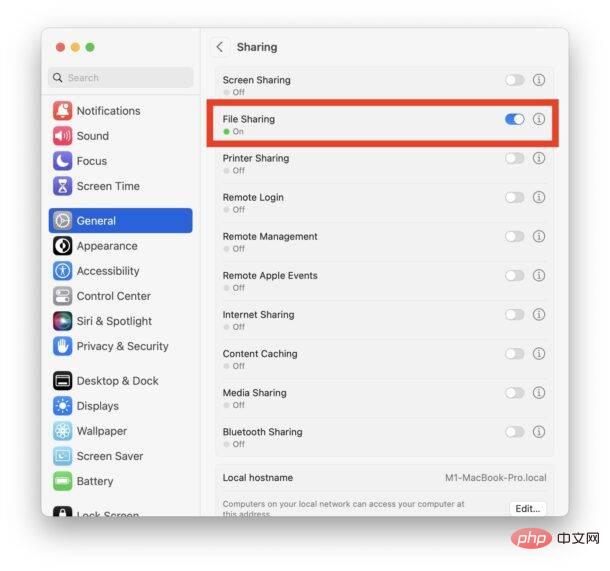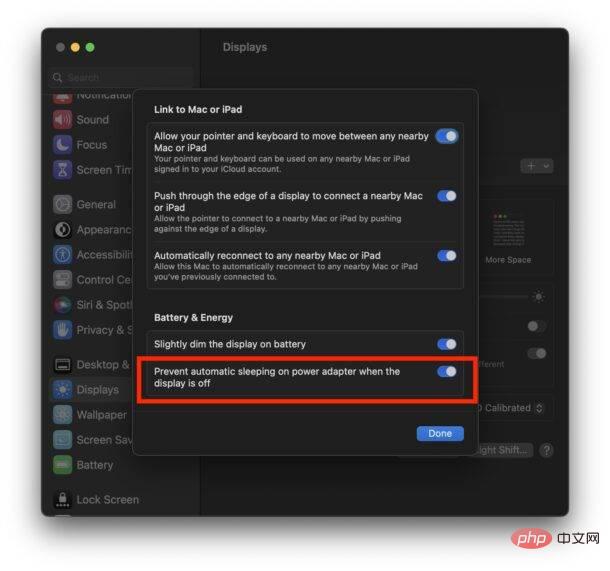php editor Apple tells you that the Mac system does not have the function of directly pasting file paths in Finder by default, which brings inconvenience to users. However, with some simple operations, we can solve this problem and let Mac paste file paths as conveniently as Windows. Next, let’s learn how to paste file paths on Mac!
How to get the file path on MAC
You can use the "Get Information" panel to view the full path of a file or folder, just find the target file or folder in Finder, right-click and Select "Get information".
On Mac, document files are typically stored in a folder called Documents, which is located under the user's home directory. You can find and access these documents through the Finder's left sidebar or by using Spotlight Search.
On Mac computers, you can use Spotlight, the built-in search tool, to quickly find files, applications, emails, and contacts. Just press the shortcut key "Command Space" to open focused search, and then enter keywords in the search bar to quickly locate the content you need. This feature is very convenient and allows you to manage and find your files and information more efficiently.
Right-click the file or folder, select "Show Introduction", and find the "Location" item in the pop-up window. This is the path. In systems before macOS 10, the path is displayed in the normal format; in systems version 10 and later, the path is displayed with a small arrow instead of "/". Note that the path does not include the file name. If quoting a path, be sure to include the filename and extension at the end.

How to copy the file path in mac system? How to copy file path in mac system
The first step is to open the target file according to the arrow in the picture below. clip, and then press the [Command A] shortcut key. In the second step, after selecting all files, press the [Command C] shortcut key according to the arrow in the picture below.
After downloading the NTFS software to your computer, double-click to install it. Then drag NTFS into the application folder. Launch NTFS for Mac.app, enter your password and click Install Helper.
The operation steps are as follows: First, select the file, and then use the shortcut key "command+c" to copy, or you can right-click and select "Copy". Then open the terminal by typing "terminal" in Spotlight and pressing the Enter key. Detailed methods of merging folders can be found in the experience of "How to merge folders on Mac".
How to display the path bar and copy the file path in the Finder window on Mac computer
The steps are as follows: First open the [Finder] window on the computer, select any file, and then click [Show] at the top options. Then in the pop-up menu bar, check the [Show path bar] option.
First open the [Finder] window, and then click the [Show-Hide Path Bar] option, or use the shortcut key [option command p] to show or hide the path bar.
Let’s start with the simplest and most intuitive way to view the current folder path: using Finder’s own path bar feature. Open a Finder window and click the View button from the top menu bar. In the menu that appears, click Show Path Bar.
First we need to open the display path of Finder.
Open any finder window and click the Show menu at the top. There is a menu item called Show Path Bar. Just hook it up. Supplement: Basic knowledge, close the cover and go. Unlike most PCs that use mechanical hard drives, Mac uses solid-state drives, so you can close the lid and go without fear of damaging the hard drive due to vibration.
In the dock bar, click Launchpad - Other _ Automator as shown in the figure. Click File - New in the Automator menu bar, and then select "Workflow".
How to paste the file path in a folder on mac
The first step is to open the two folders in sequence, then select all the files, and then drag them according to the arrows in the picture below. to the destination folder window. Finally, as shown in the picture below, the file is successfully pasted into the new folder.
Copy: First select text or other items for copying or cutting. Then, follow one of the following steps to save the item to your clipboard so you can paste it elsewhere. Paste: First click to place the insertion point, then follow one of the following steps to paste the item you copied at that location.
Mac shortcut keys to copy files Step 1: Hold down the shortcut key "Command C" to copy the file; Step 2: Select the path and hold down the Mac shortcut key "Command V" to paste the file.
Macbookpro quickly copies the file path without displaying the introduction
Step 1: Select the file, open the Mac right-click menu (after installing the Mac right-click menu tool), right-click "Copy to"; Mac right-click The second step of the menu tool: select a path (file saving location). In this way, you can copy files on your Mac to other locations.
The steps are as follows: First, select the file, and then use the shortcut key "command+c" to copy, or you can right-click and select "Copy". Then open the terminal by typing "terminal" in Spotlight and pressing the Enter key. Detailed methods of merging folders can be found in the experience of "How to merge folders on Mac".
Select the text you want to copy and paste. Press command C on your keyboard to copy the text. Just press command V on your keyboard to paste the text.
Command-Shift-N creates a new folder (New), Command-Shift-G brings up the window, and you can enter the absolute path to the folder (Go). Return is not actually a shortcut key. Click on the file and press Files can be renamed under Command-O to open the selection.
Power button or Touch ID sensor: Press to turn on your Mac or wake your Mac from sleep. When your Mac is awake, pressing and holding this button for 5 seconds will put your Mac to sleep. Continuing to hold down will force your Mac to shut down.
Conclusion: The above is a summary of the answers that this site has compiled for you about the problem that Mac cannot paste file paths. I hope it will be helpful to you! If your problem is solved, please share it with more friends who care about this problem~
The above is the detailed content of Can't paste file path on mac?. For more information, please follow other related articles on the PHP Chinese website!
 ip与mac绑定什么意思Mar 09, 2023 pm 04:44 PM
ip与mac绑定什么意思Mar 09, 2023 pm 04:44 PMip与mac绑定是指将特定的IP地址与特定的MAC地址关联起来,使得只有使用该MAC地址的设备才能够使用该IP地址进行网络通信。ip与mac绑定可以防止被绑定的主机的IP地址不被假冒,前提条件:1、MAC地址是唯一的,并且不可假冒;只能绑定与路由器直接相连的网络上的主机(也就是主机的网关在路由器上)。
 mac版下载是什么意思Mar 06, 2023 am 09:52 AM
mac版下载是什么意思Mar 06, 2023 am 09:52 AMmac版下载的意思是当软件在选择安装时,选择MAC版下载;Windows版和MAC版是两个不同的操作系统,所以大多数软件在选择安装的同时需要选择Windows版还是MAC版。
 mac鼠标滚轮相反怎么办Mar 16, 2023 pm 05:44 PM
mac鼠标滚轮相反怎么办Mar 16, 2023 pm 05:44 PMmac鼠标滚轮相反的解决办法:1、打开mac电脑,点击屏幕的苹果标志,然后选择“系统偏好设置”;2、在“系统偏好设置”窗口中,选择“鼠标”;3、在“鼠标”窗口中,将“滚动方向:自然”前面的勾去掉即可。
 修复文件共享在 MacOS Ventura 中不起作用Apr 13, 2023 am 11:34 AM
修复文件共享在 MacOS Ventura 中不起作用Apr 13, 2023 am 11:34 AM修复 SMB 文件共享在 MacOS Ventura 中不起作用的问题从 Apple 菜单打开 Mac 上的“系统设置”应用程序转到“常规”,然后转到“共享”找到“文件共享”的开关并将其关闭通过转到 Apple 菜单并选择重新启动来重新启动 Mac重新启动后,返回共享系统设置面板并将“文件共享”重新设置为打开位置像往常一样恢复文件共享,它应该按预期工作如果 MacOS Ventura Mac 与另一台 Mac 或设备之间的文件共享突然再次停止工作,您可能需要在几天后或随机重复此过程。
 如何防止 Mac 在显示器关闭时进入睡眠状态 (MacOS Ventura)Apr 13, 2023 pm 12:31 PM
如何防止 Mac 在显示器关闭时进入睡眠状态 (MacOS Ventura)Apr 13, 2023 pm 12:31 PM显示器关闭时如何防止 Mac 休眠如果您希望 Mac 显示器能够在整个计算机不进入睡眠状态的情况下关闭,请在此处进行适当的设置调整:下拉 Apple 菜单并转到“系统设置”转到“显示”点击“高级...”切换“防止显示器关闭时电源适配器自动休眠”的开关现在 Mac 显示屏可以关闭,同时防止 Mac 本身进入睡眠状态。这可能主要与 Mac 笔记本电脑用户相关,但即使是那些没有 MacBook 的用户也可能会发现该功能很有用。
 mac克隆是什么意思Jan 31, 2023 am 10:33 AM
mac克隆是什么意思Jan 31, 2023 am 10:33 AMmac克隆全称mac地址克隆,是固化在网卡上串行EEPROM中的物理地址,通常有48位长。mac克隆一般应用在路由器上,用户在用电脑直接拨号上网,后来又加了个路由器,通过路由器来实现多台电脑同时上网,这时要用到mac地址克隆了,就是把当前的电脑的mac地址克隆到路由器中去,因为运营商是把你的电脑mac地址绑定你的账号的,所以得克隆以后才能用。
 mac的shift键是哪个键Mar 13, 2023 pm 02:20 PM
mac的shift键是哪个键Mar 13, 2023 pm 02:20 PMmac的shift键是fn键上方、caps lock键下方的一个键,该键在键盘最左侧,由右下往上数第2个键;shift键是键盘中的上档转换键,可以通过“Ctrl+Shift”组合键来切换输入法。
 mac解压rar用什么软件Mar 03, 2023 pm 04:18 PM
mac解压rar用什么软件Mar 03, 2023 pm 04:18 PMmac解压rar的软件:1、The Unarchiver,是一款完全免费、小巧,而且非常易于使用的压缩、解压缩小工具;2、Keka,是一款免费、实用的压缩、解压缩工具,支持解压缩RAR格式的压缩包;3、360压缩大师,是一款免费的压缩、解压缩软件,完全支持RAR文件解压;4、MacZip,支持包括RAR在内的超过20种压缩格式的解压;5、BetterZip;6、FastZip。


Hot AI Tools

Undresser.AI Undress
AI-powered app for creating realistic nude photos

AI Clothes Remover
Online AI tool for removing clothes from photos.

Undress AI Tool
Undress images for free

Clothoff.io
AI clothes remover

AI Hentai Generator
Generate AI Hentai for free.

Hot Article

Hot Tools

EditPlus Chinese cracked version
Small size, syntax highlighting, does not support code prompt function

Dreamweaver Mac version
Visual web development tools

ZendStudio 13.5.1 Mac
Powerful PHP integrated development environment

SublimeText3 Mac version
God-level code editing software (SublimeText3)

mPDF
mPDF is a PHP library that can generate PDF files from UTF-8 encoded HTML. The original author, Ian Back, wrote mPDF to output PDF files "on the fly" from his website and handle different languages. It is slower than original scripts like HTML2FPDF and produces larger files when using Unicode fonts, but supports CSS styles etc. and has a lot of enhancements. Supports almost all languages, including RTL (Arabic and Hebrew) and CJK (Chinese, Japanese and Korean). Supports nested block-level elements (such as P, DIV),







